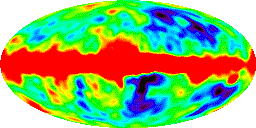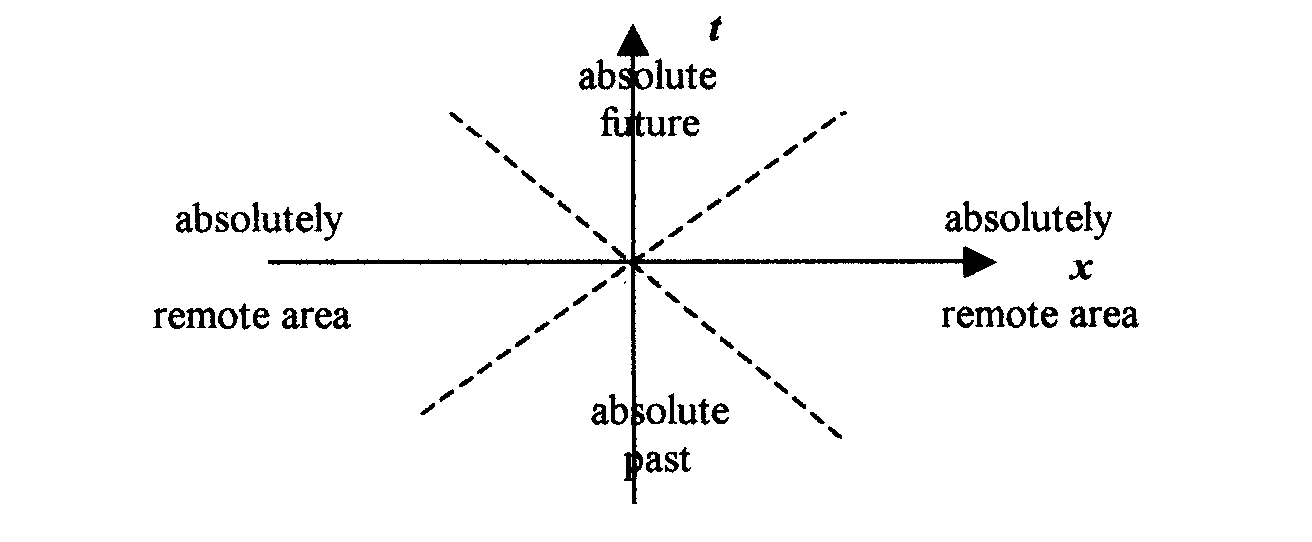
У M. H. Shulman
On an experimental validation
of the selected reference frame existence in the Universe
At the border between the 19th and the 20th centuries the absolute space concept seemed to be rejected forever. The Michelson and Morley’s experiments and the Einstein’s Special Relativity proved, that any selected inertial reference frame couldn’t exist.
Meanwhile, in 1965 Arno Penzias and Robert Wilson were conducting a careful calibration of their radio telescope at the Bell Laboratory at Whippany, New Jersey. They found that their receiver showed a "noise" pattern as if it were inside a container whose temperature was 3K - i.e. as if it were in equilibrium with a black body at 3 K. This "noise" seemed to be coming from every direction. In 1978 Penzias and Wilson were awarded the Nobel prize in physics for this discovery. This radiation was identified as cosmic microwave background radiation (CMBR) and supposed to be connected with the Universe early process.
A black body at 3 K emits most of its energy in the microwave wavelength range. Molecules in the earth's atmosphere absorb this radiation so that from the ground, astronomers cannot make observations in this wavelength region. So, these measurements were executed firstly from the stratosphere using planes and balloons and then from the open space using satellites. When cosmologists first looked at the microwave sky, thirty years ago, they noticed it was nearly uniform. As observations improved, they detected the dipole anisotropy. Finally, in 1992, the Cosmic Background Explorer (COBE) satellite made the first detection analogous to seeing "mountains on the surface of the Earth": it detected cosmological fluctuations in the microwave background temperature.
The noted Russian scientist J.B. Zeldovitch wrote in the Editorial Addition to [1] that careful measurements allowed find out some anisotropy of CMBR. An antenna oriented to the Lion constellation detects that the radiation temperature is 0.013% more, than mean. The radiation temperature in the opposite direction is 0.013% less, than mean. Generally, a temperature varies continuously between these two values. The isotropy presents only for some imaginary observer. The Solar system, Earth move to the Lion constellation relative to this observer having velocity 390 ± 60 km/s. Hence, as a result of the Doppler effect, a meeting radiation seems be more hot, and an overtaking radiation seems be more cold. This example shows that an observer exists in every point of the Universe, for which a CMBR is isotropic. We may consider this observer and a connected reference frame as selected. The selected reference frame existence at the Universe every point looks like the physicists commonly held view preceding to Relativity. They thought that the light presents the ether oscillations occupying whole the Universe. They thought also that a reference frame connected with ether is preferable, or selected. They tried to detect the Earth motion relative to ether. We know that these experiments gave the negative result: any ether doesn’t exist. But the Universe evolution follows that when CMBR is observed (and only in this case!), the selected reference frame (called sometime “new ether”) appears. This new ether at one place is moving relative to new ether at other one. The new ether or CMBR just realises the motion according to Hubble’s law.
The COBE satellite was developed by NASA's Goddard Space Flight Center to measure the diffuse infrared and microwave radiation from the early universe, to the limits set by our astrophysical environment. It was launched November 18, 1989 and carried three instruments, a Far Infrared Absolute Spectrophotometer (FIRAS) to compare the spectrum of the cosmic microwave background radiation with a precise blackbody, a Differential Microwave Radiometer (DMR) to map the cosmic radiation sensitively, and a Diffuse Infrared Background Experiment (DIRBE) to search for the cosmic infrared background radiation. The cosmic microwave background spectrum was measured with a precision of 0.005%; the background was found to have intrinsic anisotropy for the first time, at a level of a part in 100,000; and absolute sky brightness maps from 1.25 microns to 240 microns were obtained to carry out the search for the cosmic infrared background, which was detected in the two longest DIRBE wavelength bands: 140 and 240 microns. The COBE instruments have a beam size of 7 degrees, which means that it can only see structures which are larger than about 14 Moon diameters in the sky.
The FIRAS instrument determined that the spectrum matches the black body theoretical curve for thermal equilibrium to within 0.03% at the temperature 2.726 К. COBE satellite detected also (during 4 years measurement) some anisotropy in the cosmic microwave background. It found, for example, one part of the sky has a temperature of 2.7281 Kelvin (degrees above absolute zero), while another part of the sky has a temperature of 2.7280 Kelvin.
The CMBR temperature deviation map (relative to mean 2.728 К) in the middle part of the spectra is presented on the figure 1. The orientation of the map is such that the plane of the Milky Way runs horizontally across the center of the image. The map displays in a scale such that blue corresponds to 2.724 Kelvin and red is 2.732 Kelvin. The "yin-yang" pattern is the dipole anisotropy that results from the motion of the Sun relative to the rest frame of the cosmic microwave background.

Figure 1. The CMBR temperature deviation map (relative to isotropic value 2.728 К). The dipole type asymmetry, blue corresponds to 2.724 Kelvin and red is 2.732 Kelvin, the whole range is 0.008 K
The figure 2 shows the microwave sky after the dipole anisotropy has been subtracted from the map. This removal eliminates most of the fluctuations in the map: the ones that remain are thirty times smaller. On this map, the hot regions, shown in red, are 0.0002 Kelvin hotter than the cold regions, shown in blue.
There are two main sources for the fluctuations seen in the last figure:
- Emission from the Milky Way dominates the equator of the map but is quite small away from the equator.
- Fluctuating emission from the edge of the visible universe dominates the regions away from the equator.

Figure. 2. The CMBR temperature fluctuation map after subtraction of the dipole anisotropy. The Milky Way radiation and fluctuations, the whole range is 0.0002 K
One of the CMBR anisotropy possible explanations given in [2] is a hypothesis postulating the early Universe structure anisotropy, different versions and parameters of the hypothesis corresponding with different angular distribution of the MCBR temperature. Somehow or other, the CMBR anisotropy is usually explained to be due to its origin, not to local anisotropy at a point (and at the moment) of the radiation detection. Hence, this anisotropy doesn’t shell appear, when we detect an artificial radiation generating by usual emitter at the Earth.
However, I proposed different explanation of this phenomena based on the new time and space concept. I do not state here this concept, but one very important assertion can be deduced from it: the unique selected orientation and velocity at every point of the Universe must exist, this velocity vector defines a selected reference frame. As this statement has be found out before I knew about the CMBR anisotropy, it is very interesting to valid or reject experimentally the new concept. On the other hand, it may hope that the new proposed experiments are interesting for physics independently of any reasons and hypothesis.
I suppose that any (electromagnetic) radiation is ideally isotropic for an observer (immobile relative to emitter) only at the selected reference frame being unique at the Universe every point. Then an anisotropy appears being due to the Doppler effect, which is defined by the measuring device motion velocity relative to the selected reference frame. The quantitative description of the anisotropy depends on the velocity divided by the velocity of light (v/c) and an angle a between real and selected motion directions. As it is known, the Special Relativity gives [3] in this case for a frequency deviation the expression:
f/f0 = [(1-v2/c2)1/2] / [1-(v/c)cos a ] ,
for small angles and in non-relativistic approximation:
f/f0 = 1+ (v/c)cos a
Using the adjusted data relative to CMBR anisotropy, we may conclude that v/c=0.0015. If this value and pointed angle dependence will valid in a new experiment with an artificial (non-cosmic) electromagnetic radiation, we will be able to draw an important conclusion relative to universal origin of the space and time anisotropy.
I propose to realise relatively simple experiments according to the following way. A usual artificial electromagnetic radiation source should be used, the direction to Lion constellation should be chosen. A source should be placed to the centre of a real or imaginary sphere, on the surface of which there are several detectors, or one detector is movable. The Doppler effect value dependence on a spatial angle relative to selected orientation should be searched. Of course, the sphere diameter should be many times more than measured radiation wavelength.
In the end, I would like to present one additional seditious thesis prejudicing the origin of CMBR connection with the Universe early processes. The Universe evolution stage consecution should have an absolute meaning, not relative. Such absolute meaning the Special Relativity put down to events being inside of the light cone, in the area of the absolute past (figure 3).
A signal coming from such events may arrive at observer only having a speed less than the light velocity. Only in this case such events precede of detection moment (by our observer) at each reference frame, the minimal time interval between moments the signal emission and receiving presents at the reference frame connecting with the signal himself.

Figure 3. The “past-future ” areas chart in the Special Relativity
However, if a signal propagation speed is equal to the light velocity (like CMBR), then we already cannot state strongly that the signal departure moment precedes of the signal detection moment in the absolute meaning.
Therefore, I believe that CMBR is coming from the contemporary Universe and consisting in a usual thermal radiation. Its spectra is like a black body one because there are no some reflective “walls” in the Universe, hence, only absorption process are essential. As for the temperature value (3 K), it allows to found out that the relation between mean thermal radiation energy and the energy at rest in the Universe is approximately equal to 10-4.
References:
[1]С.Вaйнбеpг. Пеpвые тpи минуты. Совpеменный взгляд нa пpоисхождение Вселенной. Москвa, Энеpгоиздaт, 1981.
[2] Я.Б.Зельдович, И.Д.Новиков. Стpоение и эволюция Вселенной. Москвa, Нaукa, 1975.
[3] Л.Д.Ландау, Е.М.Лифшиц. Теория поля. Москвa, Нaукa, 1967.